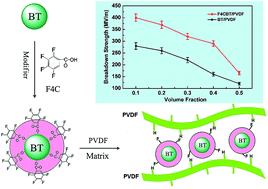Fluorocarboxylic acid-modified barium titanate/poly(vinylidene fluoride) composite with significantly enhanced breakdown strength and high energy density
Abstract
Ceramic/polymer composites combining high permittivity fillers and a high breakdown strength matrix have shown great potential for applications in power systems. However, the compatibility between the two phases in the composite is always a key factor influencing its dielectric performance. The surface modification of the fillers using traditional modifiers can improve the breakdown strength of the composites but also increase the dielectric loss at the same time, which reduces the energy efficiency of the material. In this work, we report a modifier for the surface modification of barium titanate (BT) nanoparticles, which, as a modifier for nanoparticles, has not been demonstrated before. The poly(vinylidene fluoride) (PVDF) composites filled with the modified BT have good compatibility, a high breakdown strength and low dielectric loss. Especially, the breakdown strength is much higher than that of the composites filled with unmodified BT nanoparticles. When the filler volume fraction is 40%, the increase in the breakdown strength can reach 81.3%. A high energy density of 9.4 J cm−3 is achieved at 400 MV m−1 when the volume fraction is 10%, which is two times higher than that of the unmodified BT/PVDF composites.


 Please wait while we load your content...
Please wait while we load your content...